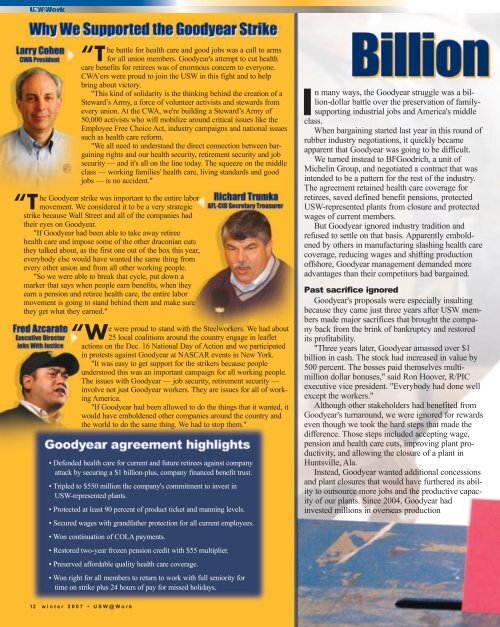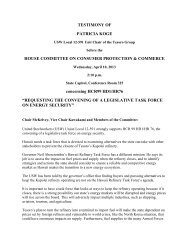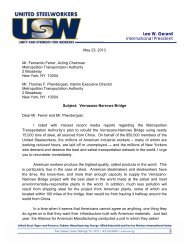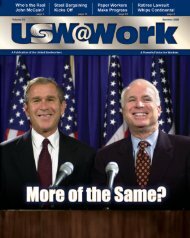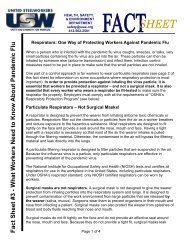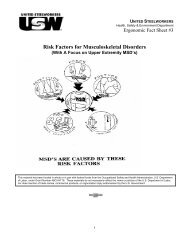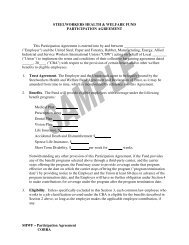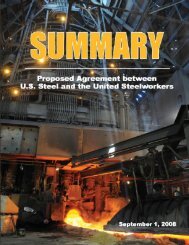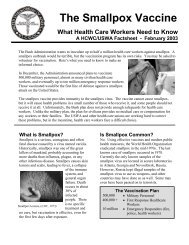USW@Work - National College Players Association - United ...
USW@Work - National College Players Association - United ...
USW@Work - National College Players Association - United ...
- No tags were found...
You also want an ePaper? Increase the reach of your titles
YUMPU automatically turns print PDFs into web optimized ePapers that Google loves.
“T“The battle for health care and good jobs was a call to armsfor all union members. Goodyear's attempt to cut healthcare benefits for retirees was of enormous concern to everyone.CWA’ers were proud to join the USW in this fight and to helpbring about victory."This kind of solidarity is the thinking behind the creation of aSteward’s Army, a force of volunteer activists and stewards fromevery union. At the CWA, we're building a Steward’s Army of50,000 activists who will mobilize around critical issues like theEmployee Free Choice Act, industry campaigns and national issuessuch as health care reform."We all need to understand the direct connection between bargainingrights and our health security, retirement security and jobsecurity — and it's all on the line today. The squeeze on the middleclass — working families' health care, living standards and goodjobs — is no accident."he Goodyear strike was important to the entire labormovement. We considered it to be a very strategicstrike because Wall Street and all of the companies hadtheir eyes on Goodyear."If Goodyear had been able to take away retireehealth care and impose some of the other draconian cutsthey talked about, as the first one out of the box this year,everybody else would have wanted the same thing fromevery other union and from all other working people."So we were able to break that cycle, put down amarker that says when people earn benefits, when theyearn a pension and retiree health care, the entire labormovement is going to stand behind them and make surethey get what they earned."“We were proud to stand with the Steelworkers. We had about25 local coalitions around the country engage in leafletactions on the Dec. 16 <strong>National</strong> Day of Action and we participatedin protests against Goodyear at NASCAR events in New York."It was easy to get support for the strikers because peopleunderstood this was an important campaign for all working people.The issues with Goodyear — job security, retirement security —involve not just Goodyear workers. They are issues for all of workingAmerica."If Goodyear had been allowed to do the things that it wanted, itwould have emboldened other companies around the country andthe world to do the same thing. We had to stop them."• Defended health care for current and future retirees against companyattack by securing a $1 billion-plus, company financed benefit trust.• Tripled to $550 million the company's commitment to invest inUSW-represented plants.• Protected at least 90 percent of product ticket and manning levels.• Secured wages with grandfather protection for all current employees.• Won continuation of COLA payments.• Restored two-year frozen pension credit with $55 multiplier.• Preserved affordable quality health care coverage.• Won right for all members to return to work with full seniority fortime on strike plus 24 hours of pay for missed holidays.In many ways, the Goodyear struggle was a billion-dollarbattle over the preservation of familysupportingindustrial jobs and America's middleclass.When bargaining started last year in this round ofrubber industry negotiations, it quickly becameapparent that Goodyear was going to be difficult.We turned instead to BFGoodrich, a unit ofMichelin Group, and negotiated a contract that wasintended to be a pattern for the rest of the industry.The agreement retained health care coverage forretirees, saved defined benefit pensions, protectedUSW-represented plants from closure and protectedwages of current members.But Goodyear ignored industry tradition andrefused to settle on that basis. Apparently emboldenedby others in manufacturing slashing health carecoverage, reducing wages and shifting productionoffshore, Goodyear management demanded moreadvantages than their competitors had bargained.Past sacrifice ignoredGoodyear's proposals were especially insultingbecause they came just three years after USW membersmade major sacrifices that brought the companyback from the brink of bankruptcy and restoredits profitability."Three years later, Goodyear amassed over $1billion in cash. The stock had increased in value by500 percent. The bosses paid themselves multimilliondollar bonuses," said Ron Hoover, R/PICexecutive vice president. "Everybody had done wellexcept the workers."Although other stakeholders had benefited fromGoodyear's turnaround, we were ignored for rewardseven though we took the hard steps that made thedifference. Those steps included accepting wage,pension and health care cuts, improving plant productivity,and allowing the closure of a plant inHuntsville, Ala.Instead, Goodyear wanted additional concessionsand plant closures that would have furthered its abilityto outsource more jobs and the productive capacityof our plants. Since 2004, Goodyear hadinvested millions in overseas production12 winter 2007 • <strong>USW@Work</strong>


